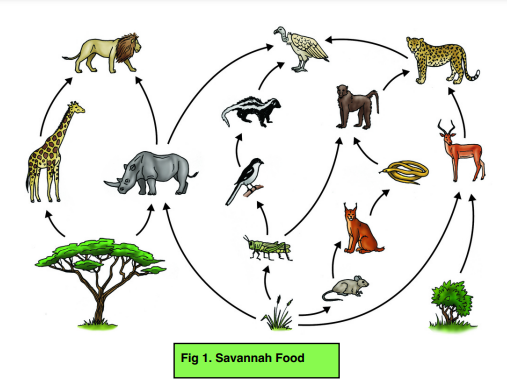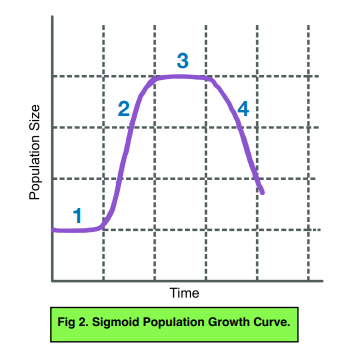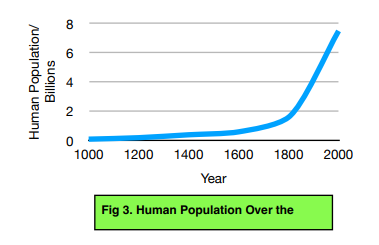Ecosystems - Ecosystems and Communities (GCSE Biology)
Ecosystems and Communities
Organisation Within an Ecosystem
Key Terms
Before discussing this topic, we must learn some basic definitions.
- Biodiversity is a measure of the variety of living organisms within a particular habitat, ecosystem, biome, or all over Earth.
- A habitat is an area where one or more organisms live. For example, a fish could have a pond as its habitat.
- A population is all of the organisms of the same species in a certain area at the same time.
- A community refers to all of the populations present inside a single habitat. For example, a pond might have populations of birds, toads, fish and insects.
- An ecosystem is the interaction of the community with all of the abiotic and biotic features in the environment.
- Abiotic factors are non-living factors and biotic factors are living factors.
Trophic Levels
- Organisms in an ecosystem are organised in a certain way. There are different levels of organisation in an organism. Different types of organisms fit into the ecosystem in different ways.
- Organisms are organised from top to bottom. There is a food chain in ecosystems. This consists of producers, primary consumers, secondary consumers and tertiary consumers. These are known as trophic levels.
- Producers photosynthesise. Producers provide energy to the ecosystem by photosynthesising to produce food. They are general algae and plants.
- Primary consumers eat producers. Primary consumers are herbivores. These are organisms that eat only plants. Examples include deer and cows.
- Secondary consumers eat primary consumers. Secondary consumers get their energy from primary consumers. Therefore, organisms at this level of organisation are called carnivores. These types of organisms eat only animals.
- Tertiary consumers eat secondary consumers. Tertiary consumers eat the secondary consumers. Organisms at this trophic level are also carnivores.
- Decomposers eat all of the above and break down organic matter after death. They do this by secreting enzymes into the environment. Soluble food molecule then diffuse into the decomposer organism.
Bacteria are an example of decomposers.
Only around 10% of energy is transferred along each trophic level. This means that food chains are highly inefficient.
Animals and other organisms get all of their supplies of nutrients and energy from the ecosystem that they are in.
You can describe different animals depending on what they eat:
- Herbivores eat plants to get energy.
- Carnivores eat other animals to get energy.
Interdependence and Competition
- Organisms can have a mutualistic relationship. Mutualism is the relationship between 2 organisms where both are gaining something. For example, flowers and bees have a mutualistic relationship as bees can get food whilst helping flowers reproduce by spreading their pollen.
- Parasites have a relationship with their hosts. Parasitism involves only parasites gaining something – the hosts don’t gain anything. For example, flees can feed on animals’ blood but they don’t give the animal anything in return.
- Organisms are dependent on one another. As we learnt above, ecosystems are very intricately linked. Each organism is inextricable linked to one another. If one relationship fails, the whole food chain can fall.
- We will use a food web to explain this principle. Looking at the example below, producers are the trees, the primary consumer is the giraffe and the secondary consumer is the lion. If there is a shortage of fruits one year, the bats will starve and so die and in turn the eagles will starve and die, as they lose their prey. Therefore, if one species is removed e.g. if humans over-harvest a food species, then the whole ecosystem suffers.

- Competition occurs usually at the same trophic level. Plants will compete with other plants for nutrients, space, light, water and minerals at the producer level. Animals will compete for territory, mates and food.
- The best adapted organisms will outcompete the others. Organisms with better adaptations will outcompete the others, therefore will survive and have more offspring.
- Competition can be interspecific or intraspecific. Competition can come from within an a species or from different species. It all depends on whether the resources required are from one species or another.
- Stable communities are the peak of an ecosystem. In stable ecosystems, the size of the community stays constant at all times. This occurs in the above describe ecosystem of the fruits, bats and eagles. In such ecosystems, even the environmental factors, such as light and minerals are balanced.
After reading this, you can understand how much damage problems such as deforestation can cause to ecosystems.
Population Growth
Sigmoid Population Growth Curve

Populations grow at different rates at different times depending on the availability of resources. This can be represented through a sigmoid curve:
- Lag Phase – there are only a few individuals so reproduction rate is low and the population is slowly increasing.
- Exponential (log) Phase – there are more individuals so the reproduction rate increases and the population size increases more quickly. There are also a lot of resources to help the individuals grow, survive and reproduce.
- Stationary Phase – the birth and death rates equalise so the population size stays stable. The population has reached the carrying capacity (maximum population size that can be supported by the environment). Limiting factors e.g. shelter, food, water are what prevent the population size from increasing more.
- Death Phase – the death rate is now faster than the birth rate so the population size decreases. This might be due to the resources in the environment being used up.
The Human Population
- The human population is increasing. The human population has rapidly increased over the last 250 years and it is still increasing. This is due to new farming methods and medical development which have reduced the number of deaths due to starvation and disease.
- The growth of the human population can be represented on graphs. There were approximately 1 billion humans in 1800 and now there are more than 7.5 billion. The fastest rate of increase in population was during the 20th century, particularly in the 1960s. Population growth has slowed down but it hasn’t stabilised.

We are physically damaging the environment for land space and wood and we’re producing more waste.






Still got a question? Leave a comment
Leave a comment